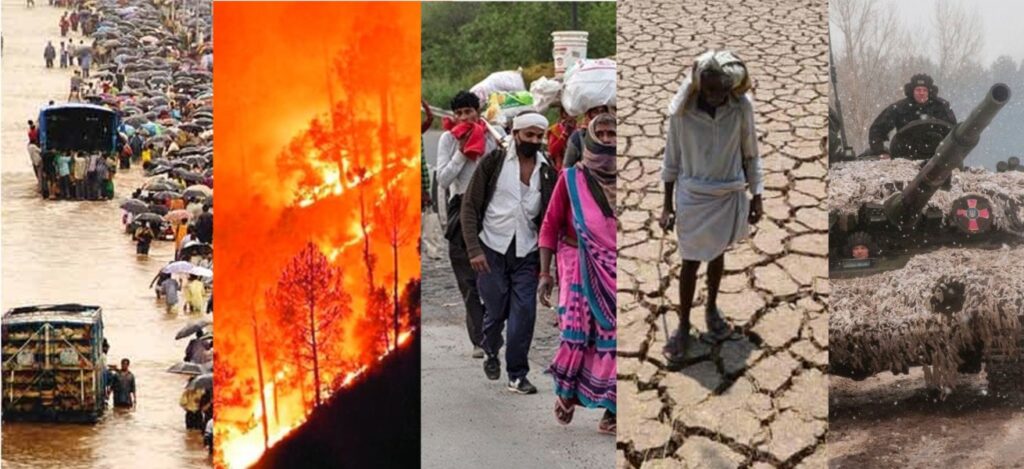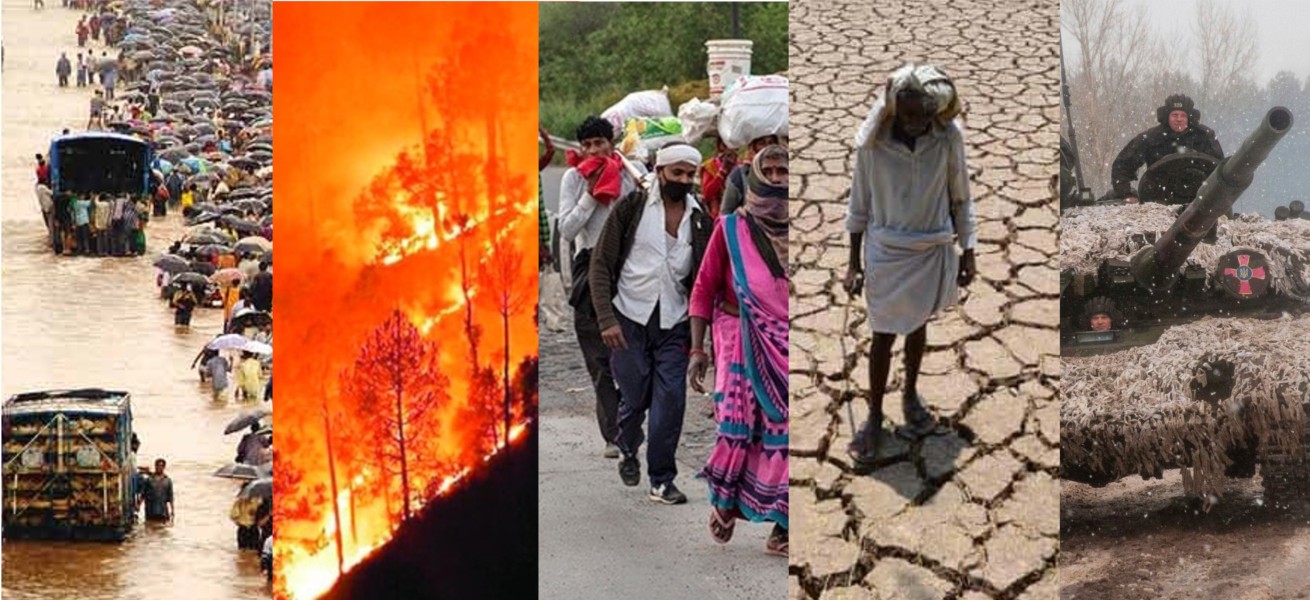
I was listening to a webinar where the coordinator asked the panelists what ordinary people ought to do to mitigate climate change. I realised that all that the panelists discussed was the European viewpoint- that to mitigate climate change, carbon emissions from the use of fossil fuels must be controlled. It was said that we could do this by replacing fossil fuels with renewable energy and by using energy more efficiently. Efficient energy use came through insulating buildings, using more efficient air-conditioning and lighting, replacing petrol and diesel-powered vehicles with electric vehicles and perhaps travelling less by air and sea.
Climate change mitigation is perceived as a business opportunity and even the war in Ukraine that has caused so much destruction and misery is seen as generating more green business, as Ukraine would be able to build better and more efficient infrastructure. Nobody talks of the carbon cost of replacing existing buildings, infrastructure and power plants with new ones. The financial institutions and even some of the environmental groups (RMI, for instance) believe that life could go on as usual and good life with economic growth would continue as long as one can ensure the efficient use of renewable energy. However, replacing fossil fuels with renewable energy to mitigate climate change is similar to replacing a dysfunctional heart in the body without fixing the reasons why that heart became dysfunctional in the first instance. Heart replacement will resolve the problem in the short run, and ensure good business for the ‘healthcare industry’, all without ensuring the long-term survival of the patient.
To mitigate climate change sustainably, one needs to discontinue redundant and wasteful consumption and change the current business trajectory that sees increasing demand as the essential thing to aim for. Increased demand (and consumption), it is argued, brings economic prosperity to people and reduced demand halts development and progress.
What changes can the world make? The world needs to get rid of wasteful and unnecessary expenditure of resources. In most countries, rich and poor, north and south, a big chunk of the national economy goes towards their military, a waste of resources for humanity. At this time when a war is being fought in Ukraine, it is difficult to see that the world could exist without military forces. Is it possible for people to come to terms with their friends and their enemies and learn to co-exist with them? Certainly, if only people could forget their dogmas, their religious biases, their national boundaries, and their favourite political systems and come together to face the single biggest existential challenge the world faces.
All issues that divide the world today, sink into oblivion when compared to climate change.
Vinod Gupta
Warring people simply have to learn to cooperate with each other. Successful examples of such cooperation were seen after the second world war. The winners (England, France, Russia, United States mainly) and losers (Germany, Italy, and Japan, mainly) lived more or less peacefully with each other after having fought a bloody war. But because they feared another World War, they continued to spend huge amounts of national resources on war materials and, as a result, the world is now on the brink of the Third World War. There are small countries like Singapore and Nepal that know their survival is possible only if they maintain good relations with their neighbours. There are others like Oman, with one-sixth the population and four times the per capita GDP of Nepal, which spends six times more of its GDP on armaments. Countries like Costa Rica and Panama spend 0% of their GDP on the military!
The world is high on substance abuse and war matériel abuse.
Vinod Gupta
The economy of countries like Colombia and Afghanistan has been controlled by cocaine and opium producers, which the world finds difficult to eliminate. Similarly, the economy of the USA, Russia and France is controlled by war material producers. While the narcotics trade has been declared illegal by most countries, the armaments trade is legal and it thrives everywhere. Even a peaceful country like India sees arms exports as the best thing for the Indian economy.
So, as long as economically strong countries (currently the USA, Russia and France) continue to depend upon arms production and exports, the world will continue to be at war.
Vinod Gupta
The amount of ecological damage caused by military operations is difficult to assess as militaries are not required to declare their fossil fuel use and carbon emissions. Even under the Paris agreement of 2015, there was no requirement for militaries to reduce their carbon emissions. The amount of carbon armaments release once they are fired, is even more difficult to assess, as it depends upon the direct and collateral destruction caused by the use of the weapon.
The world economy is locked in an ever-increasing spiral of wasteful consumerism. As a result of relentless advertising in market economies, consumers have come to equate happiness with consumption. Big consumers are lionised and rewarded, as in frequent flyer miles and credit card rewards. Not only that, the policies that the world follows today allow global businesses to grow at the cost of more sustainable local economies.
Since consumption, wasteful or otherwise, carries no penalty for ecological damage (carbon emissions) caused by it, the perception is that less consumption will likely cause ‘unhappiness’ and a shortfall in revenue required to finance climate change mitigation and adaptation. If and when, the consumers and producers begin to pay for the ecological damage to the planet, consumeristic behaviour will be more amenable to change for the better.
There are things that affect climate change but were left out of COP26 in Glasgow where they mainly discussed ways of decarbonising the economy. They did not discuss that lifestyles and business practices need to change.
It was assumed that country would decide what changes are acceptable to its population (NDC or Nationally Determined Contributions) and reduce its carbon emissions accordingly. This would be fine if all countries were equal consumers and equally capable of mitigating climate change.
Vinod Gupta
Some environmentalists in the Western world are now convinced that their economy cannot continue to grow indefinitely in a finite world, and are now talking about ‘degrowth’. Decarbonisation and Degrowth, both are Western ideas of relevance for the Global North with its high levels of consumption, but not for the poor people in the Global South, who need more energy and more growth so that their population can reach a reasonable level of prosperity. The present level of consumption in these countries is so low that they are in no position to reduce their energy use or their consumption. The poor countries may add energy generation capacity from carbon emission-free sources, but this will not lead to shutting down existing fossil fuel-burning power plants as they need additional power plants anyway. India is a good example of this – all the new renewable energy installations have not resulted in the shutting down of any coal-fired plants.
That brings me to the point – what does an ordinary person do to deal with climate change? It is clear that mitigation of climate change requires a global effort and that small personal effort will not yield any great results. In fact, individual efforts by countries will also not yield many results. But the effects of climate change are being felt by individuals, many of whose lives have been disrupted and some taken away. Heat waves, drought, wildfires, torrential rain, flash floods, landslides, urban floods, super cyclones, and rising sea levels are commonplace now. Other indirect effects of climate change are epidemics and pandemics, climate refugee migration, water and food shortages and regional wars. These effects are being experienced today and will accelerate in times to come. Policies that will create resilience against these effects are required.
Since it is individuals who have to deal with the effects of climate change, individual action is needed to help adapt to climate change.
Vinod Gupta
The case of Srilanka is interesting. The country’s economy was highly dependent upon tourism which disappeared due to the COVID-19 pandemic. The country had just stopped importing fertiliser without creating alternatives for it. That devastated agriculture and created food shortages. There are also fuel shortages as the country does not have sufficient foreign exchange to import fuel. The economy has collapsed and the country is looking for a bail-out from IMF. But there are other lessons to learn. To deal with food shortage, people are asked to grow food in their own backyards. Cuba went through a similar experience when the USA imposed trade embargoes on them in 1962. The country became independent of food and fertiliser imports by growing food in urban areas. Each family or neighbourhood community can grow their own food to guard against possible food shortages.
The case of Pakistan is much more difficult. Unprecedented floods have devastated one-third of the geographical area and about one-seventh of the population of the country. The floods have destroyed crops, food grain stocks, water sources, buildings, infrastructure of all kinds and the lives of people, mainly in the rural areas of the country. When infrastructure is rebuilt, it will need to be very different and resilient against floods as well as droughts. Low-lying areas, prone to severe flooding would need to be redefined and no new construction should take place there. This is where individual action is needed. In any case, shelters high enough to be safe in floods and others safe in case of severe winters and severe summers need to be built as temporary accommodations for populations badly affected.
The task of moving the population to safer areas is challenging and not given sufficient importance by governments. A good example has been set by the Government of Indonesia which is moving its capital away from Jakarta – a sinking city, to a safer place on the island of Borneo. No such action seems to be contemplated in Mumbai which is built on reclaimed land and faces frequent and severe floods. The idea that technology and money can take care of the effects of climate change seems to be driving official policy in India. New towns under the Delhi-Mumbai Industrial Corridor (DMIC) are planned in areas prone to flooding and to severe water shortages. Individuals can protect themselves by not moving to or investing in places with high risk due to climate change effects.
An important lesson in resilience against climate change effects was learnt during the COVID-19 pandemic. People discovered and appreciated what they already had and survived without consumerism. With no public transport, places within walkable and cyclable distances gained importance. With offices closed, people learnt to work from home. Neighbourhood communities became important.
If taken to a logical conclusion, this situation could have created self-sustaining communities but unfortunately, the lessons were quickly forgotten once the pandemic abated.
Vinod Gupta
This is an area where individual action is needed to help create self-sufficient neighbourhoods where children learn and play and where people can live and work.
Also read: The Flood of Disillusionment, by Kavas Kapadia








